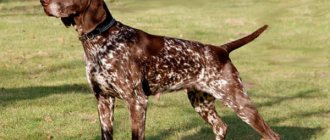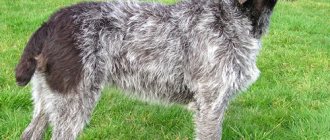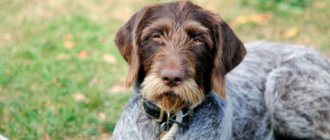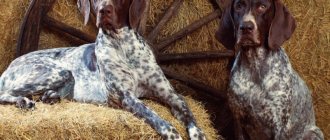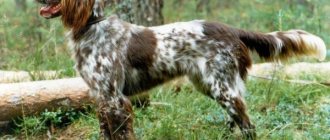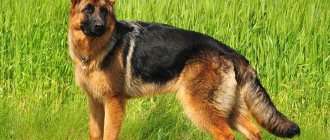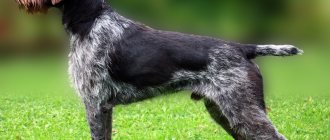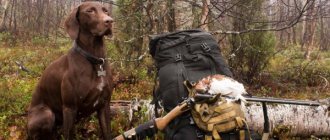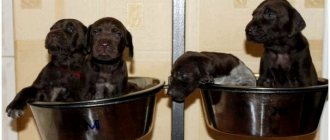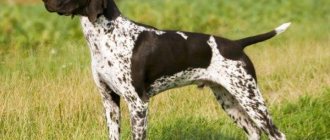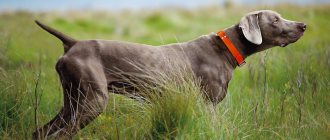Brief historical overview
The history of the German Shorthaired Pointer begins with dogs that were used for hunting game birds with nets, primarily in Mediterranean countries, and for falconry. Pointing dogs found their way to the princely German courts through France, Spain and Flanders. The most important quality of these dogs was the ability to stand. The demand for a standing dog increased after the production of the first double-barreled shotgun (1750). “Feathered game in flight” was shot in front of the dog. This was the beginning of the transition from a pure stand-up pointing dog to a well-rounded gun dog.
Since 1897, the “Stud Book of the German Shorthaired Pointer” has appeared, a decisive document for the formation and development of dog breeding. It was Prince Albrecht zu Solms-Braunfels who established the characteristics of the breed, the rules for judging conformation, as well as simple rules for testing hunting dogs. Today, the Shorthaired Pointer breed undergoes rigorous breeding and testing regulations.
The standard defines what qualities a versatile hunting dog, the German shorthaired pointer, should have. It obliges to fulfill all requirements for hunting dogs, including the oldest ones.
Character and behavior
The shorthaired pointer is a cheerful and cheerful dog with an energetic temperament and friendly disposition. He quickly becomes attached to his owners and does not like to be left alone for a long time. Deprived of communication with members of the household, the German shorthaired pointer will find entertainment on its own. To keep himself busy, a bored dog can damage his owner's property or howl for a long time.
Like other hunting dogs, the shorthaired pointer does not show aggression towards strangers. The maximum that a cop will do when invading its territory is to make a fuss with its loud barking. Therefore, those who count on a bonus in the form of protection should not get a Shorthaired Pointer.
The German Pointer tends to be dominant. In the absence of a strong, strong-willed owner, the dog easily gets out of control and becomes uncontrollable. Therefore, he needs an owner with a strong character.
The shorthaired pointer gets along well with other dogs. But the pointer may consider cats, rodents and ornamental birds prey and will begin to hunt them. Therefore, it is better not to keep it together with canaries, guinea pigs and other small animals.
Breed and children
Despite the good-natured nature of the shorthaired pointer, it is better not to get one for those who have kids. An energetic and temperamental dog may accidentally push a child or frighten him with his activity.
But the German shorthaired pointer will easily find a common language with teenagers and become their best friend for long walks and ball games.
Head
Dry, characteristic, neither heavy nor light, consistent with strength and length. bodies.
Parietal part. Cranial bones Quite a wide, flat convex skull, weakly defined occipital protuberance, not too deep frontal folds, clearly defined brow ridges. Frontal bone (transition from forehead to muzzle) Moderately expressed. Cranial bones of the muzzle. Nose The nose protrudes slightly. The nostrils are quite wide and mobile. Basically brown, but black or speckled dogs have black. Only with a dominant white color is a reddish or speckled nose acceptable. Muzzle A long, wide, deep and strong muzzle to facilitate the dog to retrieve game correctly. When viewed from the side, the bridge of the nose shows a straight line with a slight hump, more pronounced in males. In the same way, a completely straight line of the bridge of the nose, which is still acceptable, is less attractive; a concave (concave) bridge of the nose is a significant defect. Lips: Fitted, not drooping too much, well pigmented. The direction from the nose to the point of separation is almost vertical, then there is a flat curve to the moderately pronounced corner of the lips. Jaw Powerful teeth and jaw, ideal, regular and complete jaw (scissor bite), with the upper row of incisors meeting the lower ones without gap, the teeth standing vertically in the jaw, 42 healthy teeth in accordance with the dental formula. Cheeks Strong, well muscled. Eyes: Medium size, not protruding or too deep set. The ideal color is dark brown. Tightly fitting eyelids. Ears. Of medium length, set high and wide, lying close to the head, smooth and hanging without curling, bluntly rounded below. Not too meaty and not too thin. They lie in front, ending approximately at the corner of the lips.
How to choose a pet
The German Pointer is not a rare breed, so purchasing one should not be a problem. To be sure of the health and purebred of the dog, it is not advisable to purchase it by hand or at the poultry market. It is better to look for a pointing dog in registered kennels or from trusted breeders.
Important! Before visiting the breeder, you need to decide on the gender of your future pet. Girls are much more affectionate and devoted. Boys are more freedom-loving and stubborn.
It is better to choose a shorthaired pointer puppy not by photo, but in person. Before you make your final decision, you need to ask:
- presence of a stamp and documents;
- living conditions for puppies;
- working qualities of parents;
- features of behavior.
Healthy shorthaired pointer puppies have an energetic and lively temperament. They are moderately curious and have no fear of strangers. Normally, they have clean ears, clear eyes, smooth fur and smooth skin without rashes or scratches.
Body
Upper profile lines Straight, slightly falling. Withers Clearly expressed. Back: Firm and well muscled. The spinous processes are hidden by muscles. Loin: Short, broad, muscular, straight or slightly arched. The transition from the back to the lower back is taut and well completed. Croup Wide and fairly long, not cut short, easily leading to the tail, with good muscles. Chest: Deep rather than broad, with a well-defined keel and, if possible, with the sternum directed far back. The sternum and elbow joint are at the same height. Well sprung ribs, not flat or barrel shaped. The rear ribs are well directed downwards. Lower profile lines and belly Easily tucked into an elegant curve, running backwards, dry. The tail is set high, strong at the base, tapering upward, of medium length. Approximately half docked for hunting use. When at rest - hanging, when in motion - set parallel and not too high above the line of the back and not strongly arched. In countries where tail docking is prohibited by law, it may remain natural. It should reach the hock and be straight or somewhat saber-shaped.
Puppy care
A purebred puppy from a good nursery moves to a permanent place of residence at the age of 2-3 months. By this point, he is already accustomed to adult food and does not require complex care. Immediately after the move, the little shorthaired pointer is allowed to get acquainted with the new possessions and is shown where he can eat and rest.
On a note. To make it easier for the pet to endure separation from its mother and littermates, they take something with the smell of a “nest” from the breeder and put it on the bed. This way the puppy will calm down and fall asleep faster.
When the little shorthaired pointer gets used to it a little, he is taught to follow certain rules and calmly endure hygiene procedures. In order not to spoil the puppy, he is not allowed to:
- bite;
- beg;
- climb on upholstered furniture.
To prevent the puppy from catching viral or infectious diseases while walking, he must be vaccinated with a complex drug. This will provide him with lasting immunity:
- to parainfluenza;
- rabies;
- leptospirosis;
- plague;
- parvo and coronavirus enteritis.
The first vaccination for a German Pointer puppy is given at the age of 8-9 weeks with a mandatory repetition after 21 days. In the future, the shorthaired pointer is vaccinated annually. Before vaccination, the dog is treated first for fleas and then for helminths. Antihelminthics are given to shorthaired pointer strictly by weight at 10-day intervals.
Forelegs
General: When viewed from the front, straight and parallel; from the side, the paws are well positioned under the body. Shoulder-scapula joint: obliquely and backwardly applying the scapula flatly. Strong, lean muscles. Good articulation between shoulder and shoulder blade. Shoulder As long as possible, with good and lean muscles. Elbows Close to the body, but not pressed into it, not turned in or out, directed far back. Good angle of articulation between shoulder and forearm. Forearm Straight, with sufficient muscles. Powerful, not rough bones. Carpal joint Strong Fore metacarpus Minimal bend in the angle of the forearm and pastern, never set too steeply. Forefeet Round to spoon-shaped, with toes tightly packed and fairly arched. Powerful claws. Rough, strong, pads. They rest parallel to the surface and are not turned in or out when standing or moving.
Care and maintenance
Shorthaired Pointers are quite large and playful dogs that are cramped in an apartment. In the warm season, it is better to keep cops in a yard with a high fence. In winter, the dog may freeze, so it is advisable to take it indoors.
In general, caring for German pointers is simple and differs little from caring for dogs of other short-haired breeds. It comes down to basic grooming, balanced feeding and regular walking.
Hygiene procedures
In order for the shorthaired pointer dog to have a presentable appearance, it is provided with minimal care:
- The eyes of a German pointer are wiped daily with a cotton pad soaked in chamomile infusion. If increased tearing, redness or excessive dryness is detected, the animal is taken to the veterinary clinic.
- The shorthaired pointer's ears require special attention. Due to the fact that they hang on the sides of the head, air ventilation deteriorates and a lot of dirt accumulates inside. Therefore, they are wiped with a cotton swab with a special lotion 2-3 times a week and examined for infections.
- The German Shorthaired Pointer's teeth are cleaned regularly with a brush or silicone brush and a small amount of animal paste. To prevent stones and plaque from appearing on them, the dog is allowed to gnaw on large bones and chewable treats.
- The shorthaired pointer's claws usually wear down naturally. But if the pointer moves little on hard surfaces, they are shortened with a nail clipper.
- The Shorthaired Pointer's short coat does not require complex grooming. It is treated weekly with a special glove or a brush with natural bristles. They bathe a German pointer no more than once a quarter.
Feeding
Any hunting dog, no matter whether it is a shorthaired pointer or a drathaar, should receive a complete, well-balanced diet. The German Shorthaired Pointer's menu should include plenty of high-protein foods. It is important that the dog receives food at approximately the same hours. And the feeding schedule is developed individually, taking into account the age of the animal:
- up to 8 weeks – 5-6 times a day;
- 2-5 months – 4 times a day;
- 6-12 months – 3 times a day.
Adult dogs of the shorthaired pointer breed are transferred to double feeding.
Industrial feed
The easiest way to provide a shorthaired pointer with a balanced diet is to use ready-made dry food. They are selected taking into account the age and physical activity of the cop, and the serving size is calculated according to the table on the package. Dry food for shorthaired pointer should be at least super premium class. It is important that it contains a sufficient amount of protein and does not contain useless additives like soy or corn.
The German shorthaired pointer eats well the following brands of food:
- Arden Grange;
- Grandorf;
- Monge;
- Brit Care.
Natural feeding
The natural diet of shorthaired pointers should include a sufficient amount of protein. Any lean meat is suitable as a source of protein: rabbit, turkey, lamb and beef.
On a note. The daily meat intake is calculated individually and amounts to 2.5% of the dog’s body weight.
The following is also added to the shorthaired pointer's diet:
- eggs;
- fish;
- cereals;
- vegetables;
- offal;
- fermented milk products.
Sea fish is given to the German cop in its raw form and twice as much as meat.
In order for the shorthaired pointer to remain energetic and healthy longer, the following are completely excluded from its menu:
- onion;
- mushrooms;
- baked goods;
- sweets;
- river fish;
- fat meat;
- tubular bones;
- sausages;
- any food from the master's table.
Walking and hunting
Shorthaired Pointers are energetic and active dogs that require daily walking. They need active walks lasting at least 2 hours. It is not enough for shorthaired pointers to just walk on a leash next to their owner. To release the accumulated energy, the dog must be able to run around without a leash and explore the surroundings.
Important! If the shorthaired pointer is deprived of the opportunity to run, it becomes unbalanced and begins to get sick.
The German Shorthaired Pointer has developed hunting instincts and can take on any game. When tracking prey, the shorthaired pointer moves like a shuttle. And when it detects feathered game, it takes a characteristic stance - it presses its front paw and stretches out like a string. After this, a properly trained dog moves forward and lifts the bird onto its wing. When a shot is fired, the shorthaired pointer remains in its place and, on command, runs to bring the prey.
On a note. An important characteristic of the breed is the innate ability to feed wounded and killed birds. Experienced hunters claim that 1 shorthaired pointer easily replaces 10 setters on a hunt.
Training and education
Shorthaired Pointers are smart dogs with good memory and high intelligence. Cops are quite amenable to training, especially if it starts at an early age. Raising a dog should be consistent and follow the principle “from simple to complex.”
At the initial stage, the puppy needs to be taught:
- run up when called;
- stop on command;
- do not pick up food from the ground;
- walk calmly on a leash;
- follow the commands “Place!”, “Sit!” and “Lie down!”
In order for the puppy to remain interested in activities, they should be short and not monotonous.
Hind limbs
General: When viewed from behind, straight and parallel. Good articulation angles. Powerful bones. Thigh Long, wide and muscular. Good articulation between pelvis and thigh. Knees: Powerful, with good articulation between shin and metatarsus. Heel (hock) joint Powerful. Metatarsus Powerful, vertically set. Hind legs. Round to spoon-shaped, with closely spaced, fairly curved toes. Powerful claws. Rough, strong, pads. They rest parallel to the surface and are not turned in or out when standing or moving.
Who is the dog suitable for?
Let us repeat once again that this is a very active dog . If you are a homebody and prefer sedate walks, then it is not quite suitable for you.
Of course, if you are a hunter, then this is a great choice, but even those who have never held a gun in their hands can get this wonderful dog. She will be a devoted friend for an active family who loves sports and fun.
The shorthaired pointer can accompany its owners on bicycle rides or roller skating . A walk with her should not be a measured stroll through the streets, but an energetic event so that the dog can run around and free itself from the energy that overwhelms it.
The breed gets along well with children , but if the child is too small, then you need to monitor the interaction between the dog and the baby: the Shorthaired Pointer may inadvertently push or knock down, just because he is too lively and playful. The breed is not suitable for older people if they are not inclined to an active lifestyle.
Color
- Brown, no markings
- brown, with small white or mottled markings on chest or feet
- dark speckled with a brown head, brown spots or specks. The main color of a dog with this color is not brown and white or white and brown, but the coat is characterized by such an internal mixture of brown and white that the result is a dog that is so valuable for use in hunting, but not conspicuous. On the inside of the hind legs and at the tip of the tail, the color is often lighter.
- Light brown mottled with a brown head, brown spots, speckles or no spots. With this color there is a small amount of brown, but white predominates.
- White, with brown markings on the head, with brown spots or speckles.
- Black color with the same shades as brown or brown-piebald
- sandy yellow allowed
- White spots on the forehead, small spots and specks on the lips are allowed.
Kinds
The shorthaired pointer is a hunting breed that has been standardized as a separate breed. It is not divided into subtypes. However, breeders took care to produce several colors of such dogs, they are:
— Black Shorthaired Pointer
— Brown shorthaired pointer
— Spotted (brown and white) shorthaired pointer
The last variety is considered the most popular.
Interesting ! Breeders of this breed claim that if yellow markings are visible on the body of an individual, it will become excellent at finding game based on its bloody trail.
Flaws
Any deviation from the above points should be considered as a deficiency, the assessment of which should be in strict accordance with the degree of deviation.
- Defects in appearance, defects characteristic of the gender type (characteristic only for a male and only for a female)
- muzzle too short
- lips that are too thick or too thin
- absence of 2 teeth in total (P1 and M3), i.e. out of all 4 P1 and 2 M3, a maximum of 2 teeth can be missing
- too light eyes, light yellow eyes of a bird of prey
- Ears too long, too short, too heavy, too narrow or tube ears
- loose, loose skin on the throat
- slightly hunched back
- croup too short
- sunken chest
- the tail is set too high above the line of the back or is very curved
- twisted elbows or markings. Clenched or unclenched nails (pads), pressed too close to the ground or set too high above the ground.
- steep (straight) hind legs
- slight barrel build, light cowhide or narrow-set paws
Nutrition
An active and energetic shorthaired pointer should be fed twice a day. Three meals a day are welcome, but in this case the portions should be reduced. Such a dog should consume about 600-700 grams of food per day. It is better to give puppies natural foods, this will allow them to fully develop. Their diet should consist of:
- Chicken by-products.
- Fresh meat.
- Dairy products.
- Vegetables and fruits.
But giving sweets and smoked foods to cop kids is contraindicated. Poor nutrition at this age can cause food allergies in the future. It is better to give a mature dog dry food, about 300 grams at a time.
Between meals, he can be given a “snack”. Hunting dogs love to chew dried pig's ear. You can purchase such a product at any pet store. Be sure to change the water in your dog's bowl daily. Make sure he always has access to it.
Vices
- lumbering, lymphatic rough-boned
- pronounced frontal bone (transition from forehead to muzzle)
- red or spotted nose (exception for dogs with a basic white color)
- sharp muzzle. Concave nasal bridge
- pincer bite or partially pincer bite (for dogs over 4 years of age, the so-called pincer bite of age does not affect the evaluation if the German Shorthaired Pointer Club confirms that the dog has a correct bite at a previous exhibition).
- clearly hunched back. Slightly sagging back.
- significant lack of chest depth. Unpronounced keel. Too flat or barrel chest
- strongly pronounced markings or strongly pronounced turned out elbows
- soft, highly elongated wrist joint
- vertical wrist
- strong cowling or barreling of the hindquarters both when moving and at rest
- overloaded hind legs
- widely spaced fingers (pads)
- flat paws
- clumsy movements
- deviations of more than 2 cm from the above norm for height at the withers
Kurzhaar price
The cost of a German Shorthaired Pointer puppy varies widely and depends on many factors. The price of a dog is influenced by the eminence of the nursery, as well as the presence of working and exhibition diplomas from the parent couple.
- A shorthaired pointer puppy without documents can be bought for 5-10 thousand rubles.
- A German pointer from titled parents can cost from 30 thousand rubles.
The shorthaired pointer is a strong and hardy hunting dog with an energetic temperament and friendly disposition. He will become an excellent companion and assistant for those who are ready to provide him with full care and education.
Disqualifying faults
- Gross deviations from the sexual type
- absence of more than 2 of all 4 P1 and 2 M3.
- Absence of one tooth or several teeth (except P1 and M3).
- Teeth that are not visible are considered missing unless the German Shorthaired Pointer Club confirms their presence at a previous show or test.
- overshot, undershot, crossbite and all their transitional forms.
- extra teeth outside the row of teeth and more than 6 incisors in the lower and upper jaw
- dental crevices and gaps between lips
- eyelids that are strongly not adjacent to the eye, ectropia, entropia, distichias (double row of eyelashes).
- severely sagging back. Rachiocampsis.
- deformed chest (eg, "displaced breast").
- wolf fingers and wolf claws
- any type of manifestation of weakness in the behavioral qualities of the breed
- Note: Males must have two apparently normally developed seminal testicles located in the scrotum.
Interesting Facts
During the existence of shorthaired pointers, a lot of interesting things happened to them:
- The name of the breed comes from two German words kurz - “short” and haar - “wool”, “hair”.
- Shorthaired Pointers have several alternative names - German Pointer or German Shorthaired Pointer.
- The shorthaired pointer and the drathaar are closely related dog breeds. They differ in the type of coat. The first has a short spine that does not get wet even in cold water. The second is covered with long, coarse hair with a double undercoat.
Comparison of breeds
Choosing a breed is a very important decision. Compatibility with your pet will depend on this. Therefore, people often do not know who to choose and consider several breed options. Who is better anyway?
- Kurzhaar or drathaar. The Drathaar has a body structure similar to the Kurk, but its coat is longer and stiffer. A striking distinctive feature is the eyebrows and beard. The color is coffee piebald, roan and liver. Draths are more assertive and aggressive, but they love family. Kurts specialize mainly in poultry, while drats are universal (you can use them to hunt small and medium-sized animals).
- Shorthaired Pointer or Pointer. The pointer works mainly with the pen and performs well in the field. Kurts are more versatile: they can hunt both on water and on land. Pointers are more reserved when communicating with their family. Kurts become strongly attached to their owners, playful and affectionate, and more tolerant of children.
- Shorthaired Pointer or Russian Spaniel. These breeds differ in the presence/absence of a stance, that is, in a different mode of action. The spaniel is versatile in working with poultry. But its effectiveness is limited by the range of the shot. Cops are more difficult to train on a feather: not every bird is suitable for this. Both breeds are not suitable for winter hunting: the spaniel will quickly get stuck in the snow, and the kurt will freeze. Spaniels are distinguished by their more compact size and will easily take root in an apartment. But their ears require careful care: they are constantly clogged with dirt. Kurts are considered generalists: there are many offers on the Internet about their training. There are significantly fewer specialists in training spaniels.
- Setter or shorthaired pointer. The setter has a thinner build and less endurance. They are also more difficult to control. Kurts are more restrained in temperament and follow orders well.
- Weimaraner or shorthaired pointer. The Weimaraner is distinguished by its large size (up to 70 cm), short smooth hair and gray color. Can be used in hunting large game. Loyal to his owner and well trained. Prone to outbursts of bad mood. But in general, non-aggressive.
To choose the right dog, it is recommended to visit hunting forums and watch the breeds you like in action.
Video
* We invite you to watch a video about the Shorthaired Pointer . In fact, in front of you is a playlist in which you can select and watch any of 20 videos about a given dog breed by simply clicking on the button in the upper right corner of the window. In addition, the material contains quite a lot of photos. By looking at them you can find out what Kurzhaar looks like.
In this article:
|
Major diseases
This breed is characterized by good health , however, it is also prone to some diseases. Most diseases are hereditary:
- Dysplasia,
- Eye diseases,
- Dermatitis,
- Epilepsy.
Dog handlers note that all these diseases occur quite rarely.
Shorthaired Pointers are prone to bloating if not fed properly, but this can easily be avoided if you leave a little time between feeding and walking.
Bitches can develop oncological lesions of the mammary gland, but when dogs are sterilized, the risks decrease significantly.
The lifespan of a dog is 12 years ; one dog out of 8 lives more than 15 years. The longest recorded lifespan of a shorthaired pointer is 17 years .
Health
The shorthaired pointer dog breed is hardy and has good health. This is necessary for difficult hunting work. But the animal must be constantly examined for possible injuries or diseases.
Diseases
Basically, shorthaired pointers require periodic vaccinations and medications against worms and fleas. During warm periods of the year it is also necessary to protect your pet from ticks.
But some diseases are worth special mention:
- volvulus;
- otitis externa;
- cataract;
- hypothyroidism;
- epilepsy;
- melanoma.
Animals may also have hereditary or acquired hip dysplasia.
Vaccinations
Vaccination of shorthaired pointer puppies:
- The first vaccination (complex) is given at 2 months. It will protect your pet from viral infections: distemper, enteritis and other types.
- After two weeks, re-vaccination is performed.
- After 3 months, the puppy can be vaccinated against rabies. This is relevant when exporting abroad. If there is no urgent need, then the vaccine should be given after 1 year.
The puppy can be taken outside two weeks after the last comprehensive vaccination.
An adult dog is vaccinated once a year with a multi-vaccine and against rabies.
Possible diseases
The described breed is susceptible to all the diseases of other tailed hunters: parasitic, infectious, non-contagious. For example, ticks are dangerous for them due to the risk of contracting piroplasmosis. The disease is very serious, the circulatory system suffers, and the animal may die.
Allergies, harmful bacteria in the body and even banal melancholy can provoke such a common problem now as licked granuloma (it is also called polyducha). This is when some place on the body licks to the point of an ulcer on the skin. Recently, breeders have also noted that German Pointers often get sick:
- melanoma;
- turn of the century;
- otitis;
- hereditary blood diseases;
- hypothyroidism;
- epilepsy.
In order to understand in time that your pet is unwell and needs help, you need to regularly visit the veterinarian for examination.
Mating
Puberty in female Shorthaired Pointers occurs at approximately 7-8 months , in males - 1-1.5 months later. At this time, strong physiological changes occur in the dog’s body, and behavior changes. Dogs may become more aggressive.
- During the period of estrus, females have noticeable red discharge. The pet will pay a lot of attention to other people's marks and worry in the presence of other females. Having noticed such changes occurring in the dog, you can begin mating.
- It is better to choose a quiet place for mating. If you decide to hold it in an apartment, then you need to arrange a separate room, from which it is better to remove all the furniture. It is better to carry out mating in a freer place - a street, a lawn. The dogs will be able to play first and get to know each other better.
- Before mating, dogs need to be given a good walk. Preferably alone.
- To get puppies, you need to choose the right day for mating. Usually this is 12-13 days after the appearance of discharge. To check if your pet is ready for mating, you need to put your hand on her rump. An indicator of readiness is the tail pulled to the side.
- The knitting itself begins with the so-called “hook” . Cable puts his head on the bitch's withers. So he constrains her movements. And if the female does not resist the cable, she makes a “sit”. First, he pinches her in the lower back with his front paws.
- Then the bitch must move her tail so that the male can get into the loop with his genitals. After several frictions, the genitals begin to swell, which leads to a “lock.” The grip will be strong. The “lock” lasts approximately 5-30 minutes , and ejaculation occurs throughout this time. Therefore, it is better not to touch the dogs at this time.
- At the end of the process, the dogs will separate themselves.
Breeders advise doing a control mating every other day.
The female can be aggressive. She will need to be calmed down. To do this, the owner must place her head on his lap.
There are also failures in mating. If there are several attempts, the animals may get tired. Then it is better to separate them into different rooms and let them rest for at least 2-3 hours or even a day.
